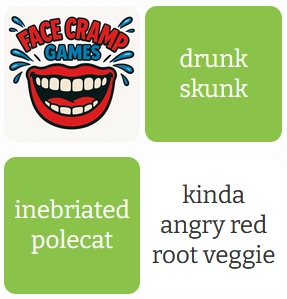Yet Another Way to Create Games
I’ve created games using many methods over my decades of being a creator of games.
timeline depicting historically accurate-ish account of events
In high school, I got my first chance to create a digital game, using some basic DOS prompts. It took hours to get the most basic interaction that rewarded the user with a super simple animation (a waving Calvin of Calvin and Hobbes).
Other than that one digital experience, up until the late ‘90’s any game I created would use tangible materials, like cardboard, construction paper, rubber bands, and other kid-friendly materials. I created a fishing for numbers game, a squirt the right answer with your squirt gun game, a rocket to the moon (with your own TP tube rocket) game, a pin the petal on the flower game…. lots of one-time use (for a party or a classroom event) games, often just re-themed versions of existing classic games.
While I continued making, essentially, paper-based games through my daughter’s elementary school years, in 1998, my dad gifted me his old computer. He was upgrading, so I got his hand-me-down 486.
I was instantly hooked on the internet, and I quickly learned basic HTML and basic Photoshop, which I applied to creating digital learning games for my preschooler. These games were, again, super basic interactions. An example: An instruction would read, “Click on the red square.” If you clicked the red square, you went to a Congrats page. If you clicked on any of the other squares, you get a Try Again page. And this was rethemed for numbers, musical instruments, animals, etc.
A friend saw what I was trying to do and introduced me to Flash 4. :::::angels singing:::::
What a game-changer that was for me. I learned to “code” games using Flash. I could draw, animate, and create much cooler interactions with much cooler rewards.
I eventually created a website for preschoolers that became pretty popular. JuliasRainbowCorner dotcom (sadly, I don’t own it anymore, but you can still find references to it out there) trading 1st and 2nd position in Google search results for “something cool” for quite some time with another website - which may or may not still exist. Kids could play games, hear music, see animations, and they could “create something cool” in lots of different ways.
That website helped me land a job that turned into a career creating digital learning games. Over time, the technology shifted to new versions of Flash and then to HTML5. I didn’t stay hands on with the coding of games, and I was happy to get to just focus on the experience itself - the stories, the characters, the rules, the flows, the rewards. I worked with a wonderful team of coders and artists to create hundreds of engaging learning games.
In a career shift about 6 years ago, I stopped having the opportunity to focus on games as part of my job.
So, back to tangible materials I went! Over the past couple of years I have created a board game, a few table top games, and a couple of card games. They are all still prototypes that I occasionally get a chance to work on, since I now do it on my own time. I still love getting my hands on physical materials to create games, and I surely always will.
But, here we are in 2025 with yet another way to create digital games. Hello, A.I.!
While many hear demons screaming when they think of A.I., I am currently having another angels singing moment. I am feeling another “the possibilities are endless” moment happening right now. It’s the late 90’s all over again - and come on, admit it - we could all use some late 90’s vibes here in 2025.
I took an afternoon to see what ChatGPT could help me with, and I am pleased to present my first whack at coding with A.I. and my first digital game in about 6 years. I started super simple with another endlessly rethemeable game mechanic - remember the matching cards, aka memory.
My first A.I. game collab:

